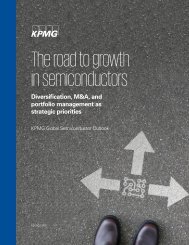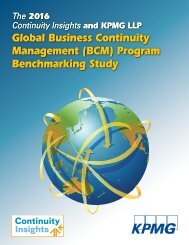Revenue for Telecoms
2cdncba
2cdncba
You also want an ePaper? Increase the reach of your titles
YUMPU automatically turns print PDFs into web optimized ePapers that Google loves.
<strong>Revenue</strong> <strong>for</strong> <strong>Telecoms</strong> – Issues In-Depth | 39<br />
3.1 Criteria to identify per<strong>for</strong>mance obligations |<br />
Observations<br />
Identifying the separate per<strong>for</strong>mance obligations is key <strong>for</strong> telecom entities<br />
Telecom entities evaluate goods and services promised to customers to<br />
determine if they are per<strong>for</strong>mance obligations that should be accounted <strong>for</strong><br />
separately. Identifying the per<strong>for</strong>mance obligations in the contract is key because<br />
it may impact the amount and timing of revenue recognition.<br />
Examples of common telecom offerings and activities that are evaluated to<br />
determine whether they are goods or services promised to the customer or<br />
merely activities that do not transfer goods or services to the customer, include,<br />
but are not limited to:<br />
– equipment – e.g. set-top boxes, wireless handsets, modems, routers, tablets<br />
(see 3.3);<br />
– cable services – e.g. basic, premium and pay-per-view services (see 3.4);<br />
– internet services, broadband or other capacity arrangements (see 3.4);<br />
– wireless services – e.g. voice, data and text plans (which may include a SIM<br />
card) and various add-on services (see 3.4);<br />
– landline voice services (see 3.4);<br />
– rights to purchase additional goods or services (see 3.4 and Section 8);<br />
– installations <strong>for</strong> home phone, internet and television, including inside and<br />
outside wiring (see 3.5);<br />
– activation of wireless handsets, set-top boxes or other equipment and services<br />
(see 3.6);<br />
– other customer services – e.g. support and other activities that may or may not<br />
result in fees charged to the customer (see 3.6);<br />
– incentives, including gift cards, or other free goods or services (see 3.7); and<br />
– warranties (see 3.8).<br />
This evaluation is per<strong>for</strong>med <strong>for</strong> all goods or services promised and activities<br />
explicitly stated in arrangements with the customer. The evaluation also takes<br />
into account implicit promises arising from customary business practices – e.g.<br />
incentives and discounts <strong>for</strong> early renewal.<br />
Materiality assessment<br />
Under both IFRS and US GAAP, when entities per<strong>for</strong>m their assessment of the<br />
per<strong>for</strong>mance obligations in the contract, they may consider materiality (that is,<br />
whether a per<strong>for</strong>mance obligation is immaterial and there<strong>for</strong>e is not accounted<br />
<strong>for</strong> separately) (see below). The examples in this section illustrate the required<br />
analysis to determine whether a promise in a contract represents a per<strong>for</strong>mance<br />
obligation, without considering the application of materiality.<br />
© 2016 KPMG LLP, a Delaware limited liability partnership and the US member firm of the KPMG network of<br />
independent member firms affiliated with KPMG International Cooperative, a Swiss entity. All rights reserved.<br />
© 2016 KPMG IFRG Limited, a UK company, limited by guarantee. All rights reserved.<br />
Home







